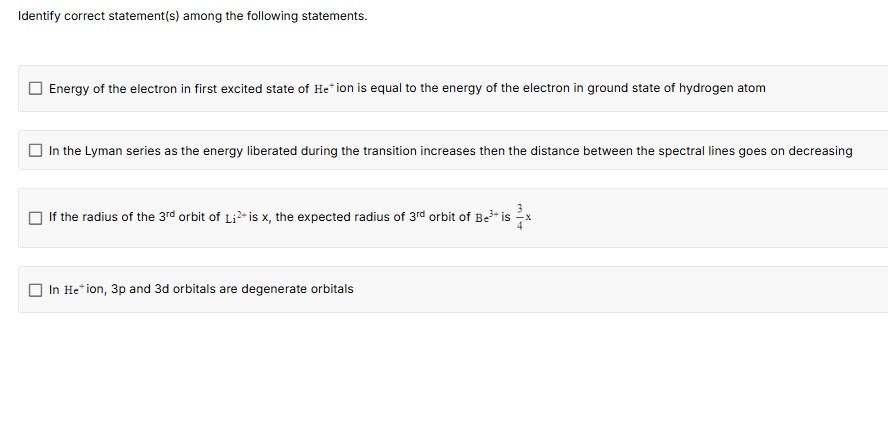Question
Question: Identify correct statement(s) among the following statements. * Energy of the electron in first e...
Identify correct statement(s) among the following statements.
-
Energy of the electron in first excited state of He+ ion is equal to the energy of the electron in ground state of hydrogen atom
-
In the Lyman series as the energy liberated during the transition increases then the distance between the spectral lines goes on decreasing
-
If the radius of the 3rd orbit of Li2+ is x, the expected radius of 3rd orbit of Be3+ is 43x
-
In He+ ion, 3p and 3d orbitals are degenerate orbitals

Energy of the electron in first excited state of He+ ion is equal to the energy of the electron in ground state of hydrogen atom
In the Lyman series as the energy liberated during the transition increases then the distance between the spectral lines goes on decreasing
If the radius of the 3rd orbit of Li2+ is x, the expected radius of 3rd orbit of Be3+ is 43x
In He+ ion, 3p and 3d orbitals are degenerate orbitals
All the statements (1, 2, 3, and 4) are correct.
Solution
Solution:
-
Statement 1:
En=−n2Z2×13.6eV.
For a hydrogen-like ion, the energy is given byFor He⁺ (Z = 2) in the first excited state (n = 2),
E2=−22(2)2×13.6=−13.6eV.This is equal to the ground state energy of H (n = 1, Z = 1), which is –13.6 eV.
→ Statement 1 is correct. -
Statement 2:
ΔE=13.6(1−n21)eV.
In the Lyman series, transitions occur to n = 1. The energy of the photon emitted isAs n increases, although the energy ΔE increases (approaching a limiting value), the difference between consecutive transitions (spectral lines) decreases because the levels converge near the series limit.
→ Statement 2 is correct. -
Statement 3:
rn=Zn2a0.
The Bohr radius for a hydrogen-like ion is given byFor Li²⁺ (Z = 3) and orbit n = 3,
r3(Li2+)=39a0=3a0.For Be³⁺ (Z = 4) and n = 3,
r3(Be3+)=49a0=49a0.Their ratio is
r3(Li2+)r3(Be3+)=39/4=129=43.→ Statement 3 is correct.
-
Statement 4:
In a hydrogen-like ion such as He⁺, the energy depends only on the principal quantum number n. Hence, all orbitals with the same n (e.g. 3p and 3d for n = 3) are degenerate (ignoring fine-structure effects).
→ Statement 4 is correct.
